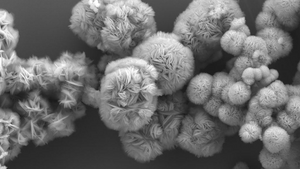Scientists at the University of Chicago have discovered a new, efficient method to create MXenes, a material composed of thin layers of metal, which can be used in high-tech electronics and energy storage devices. Previously, creating MXenes was a difficult and time-consuming process, involving several chemical engineering steps and the use of hydrofluoric acid, a toxic substance that presented waste disposal issues. However, the new method allows scientists to create MXenes from simple and inexpensive precursors without using hydrofluoric acid. The team discovered new chemical reactions that allow scientists to create MXenes from various metal alloys or different ion flavorings. The process is less toxic, produces fewer byproducts and is ideal for creating large amounts of MXenes for commercial use.
UChicago Scientists Develop New, Easy Method to Create Atomically-Thin Metal Layers for High-Tech Devices
Scientists at the University of Chicago have discovered a more efficient and less toxic method for creating MXenes, a material composed of many thin layers of metal, between which different ions can be inserted for various purposes. MXenes are potentially useful for creating high-tech electronics and energy storage devices, but previously they were very difficult and time-consuming to make.
MXenes were discovered in 2011 and are composed of thin layers of metal that maintain their ability to conduct electricity despite being only a few atoms thick. MXenes are also customizable, with scientists able to insert ions between the layers to store energy or block electromagnetic wave interference.
However, previous methods of creating MXenes involved several intensive chemical engineering steps, including heating a metal mixture at 3,000°F and then bathing it in hydrofluoric acid.
The new method, which produces fewer toxic byproducts, is expected to spur new innovation and make MXenes more viable for everyday electronics and devices. The scientists hope that this new discovery will help pave the way for the use of MXenes in high-tech devices and energy storage.
The study, which was published in Science, was led by chemistry graduate student Di Wang and postdoctoral scholar Chenkun Zhou. With this discovery, the scientists are optimistic that MXenes will be used more frequently in the future for high-tech applications.
UChicago Scientists Discover New, Efficient Method to Create MXenes Without Toxic Waste
Scientists at the University of Chicago have discovered a new, more efficient method of creating MXenes, a material composed of thin layers of metal that can be used in high-tech electronics and energy storage devices. Until recently, creating MXenes was a labor-intensive process that involved several chemical engineering steps and the use of hydrofluoric acid, a toxic substance that presented waste disposal issues.
However, the new method developed by the UChicago team allows scientists to create MXenes from simple and inexpensive precursors without using hydrofluoric acid. The process involves mixing several chemicals with the metal, heating the mixture at 1,700°F, and then exposing the layers of metal. The method is less toxic and produces fewer byproducts, making it ideal for creating large amounts of MXenes for use in commercial products.
The team discovered new chemical reactions that allow scientists to create MXenes from various metal alloys or different ion flavorings. The easier, less toxic method also makes it possible to explore new varieties of MXenes for different applications.
“These new MXenes are also visually beautiful,” said Di Wang, a chemistry graduate student at UChicago and co-first author of the paper. “They stand up like flowers, which may even make them better for reactions because the edges are exposed and accessible for ions and molecules to move in between the metal layers.”
The research was conducted using the principles of atom economy, which seeks to minimize the number of wasted atoms during a reaction. The team included chemistry graduate student Wooje Cho, and was led by Professor Dmitri Talapin, a joint appointee at Argonne National Laboratory and the Ernest DeWitt Burton Distinguished Service Professor of Chemistry at the University of Chicago.
The study was published in Science and made possible by help from UChicago colleagues across departments, including theoretical chemist Suri Vaikuntanathan, X-ray research facility director Alexander Filatov, and electrochemists Chong Liu and Mingzhan Wang of the Pritzker School of Molecular Engineering. Electron microscopy was performed by Robert Klie and Francisco Lagunas with the University of Illinois Chicago.
The new method of creating MXenes opens up new avenues for scientists to explore the material’s potential applications in high-tech devices and energy storage. The study was conducted in part at the U.S. Department of Energy’s Advanced Materials for Energy-Water Systems and the Center for Nanoscale Materials at Argonne National Laboratory.
Don’t miss interesting posts on Famousbio










